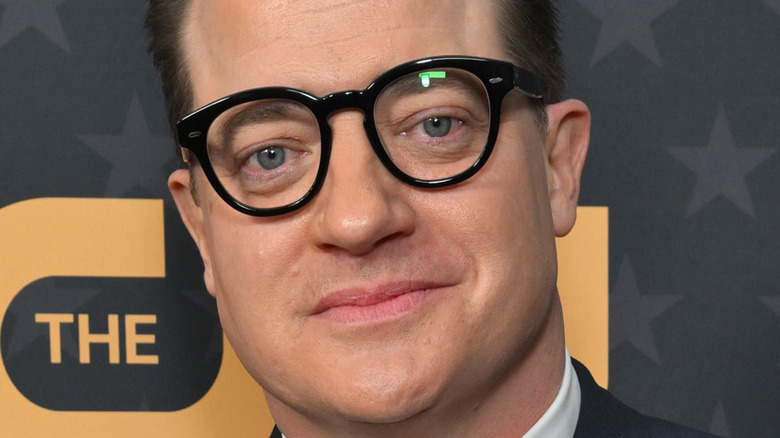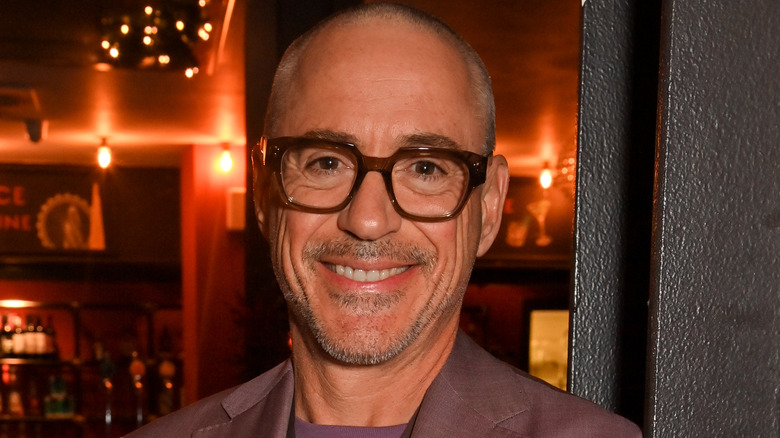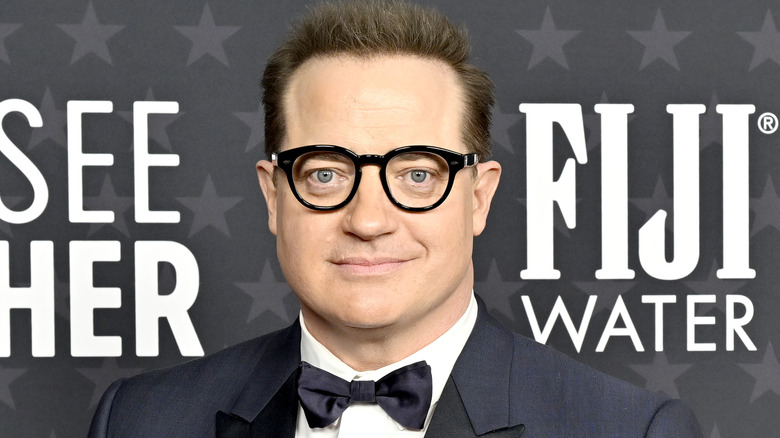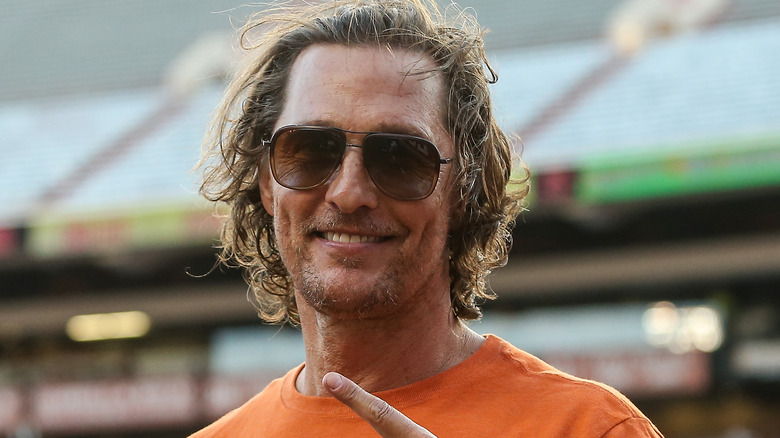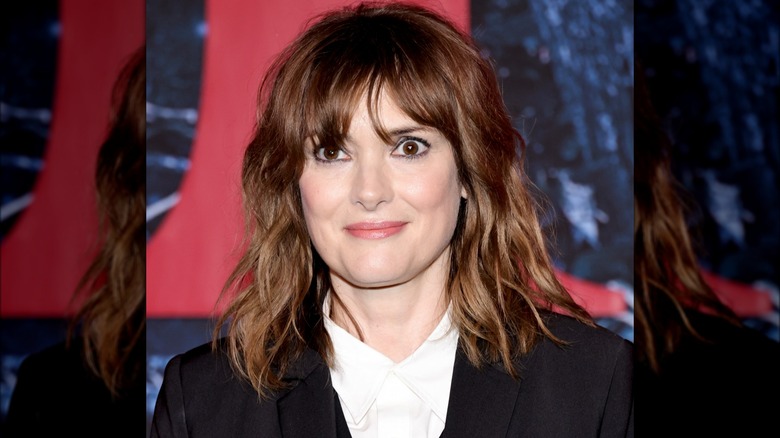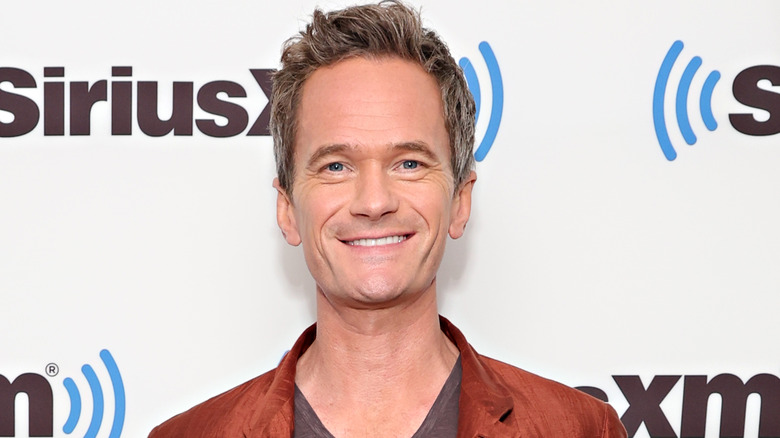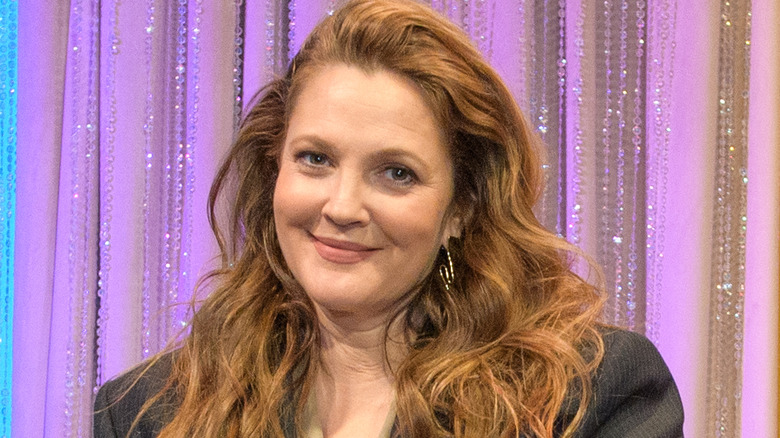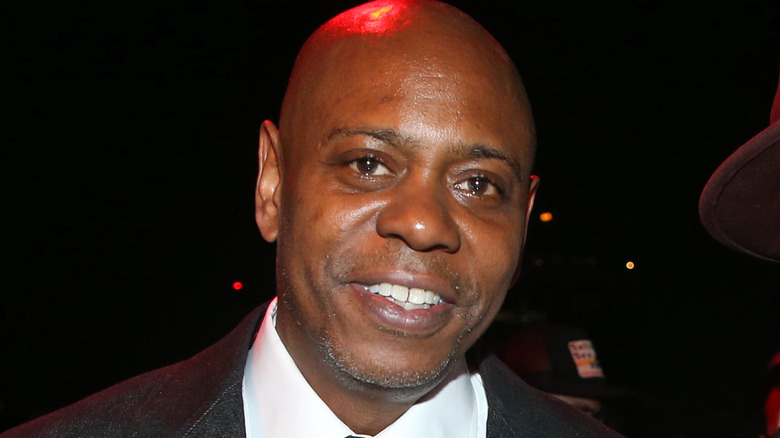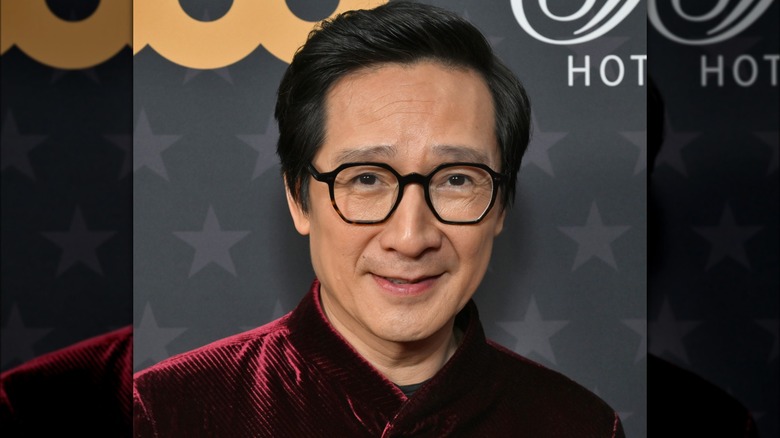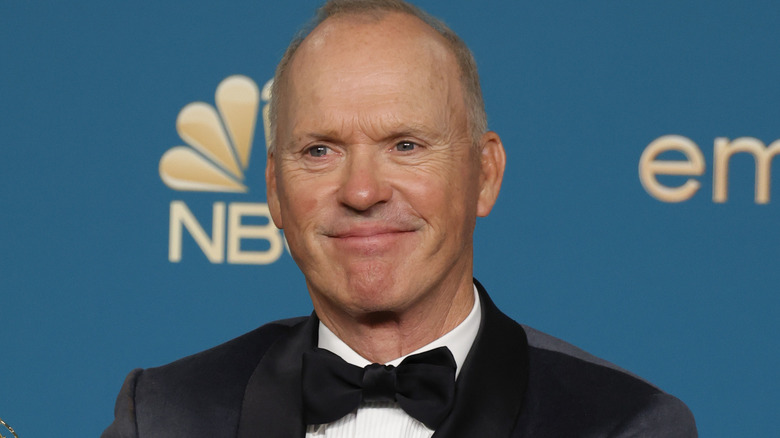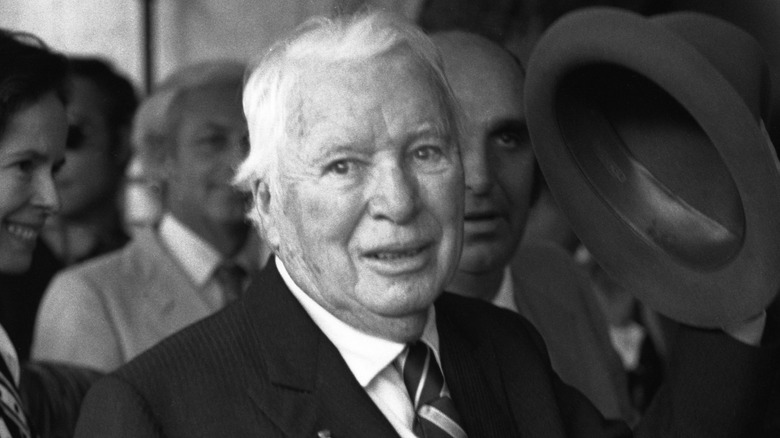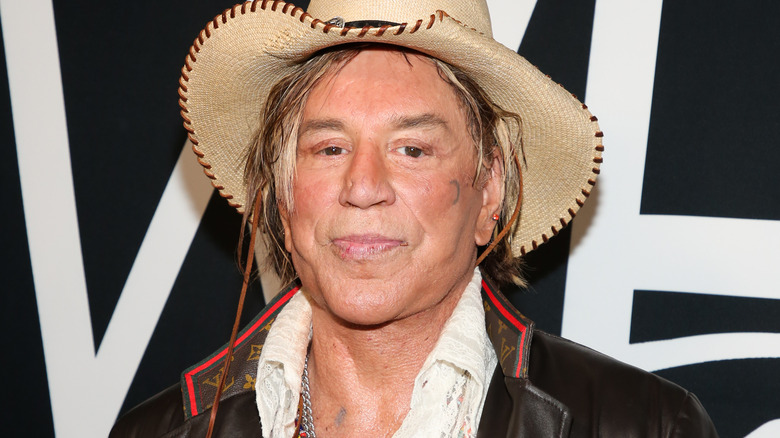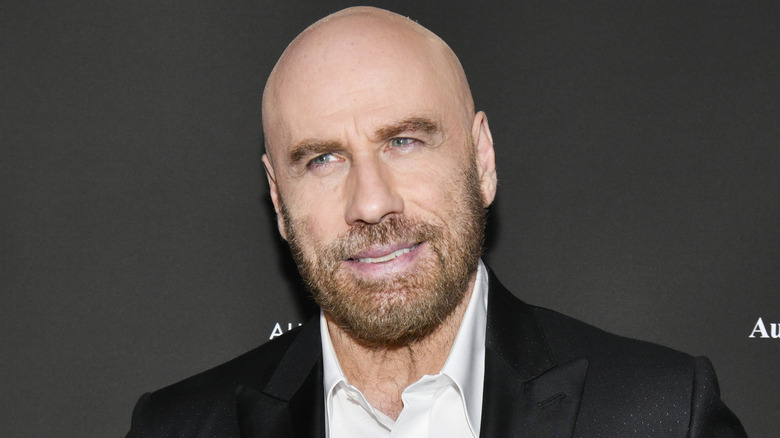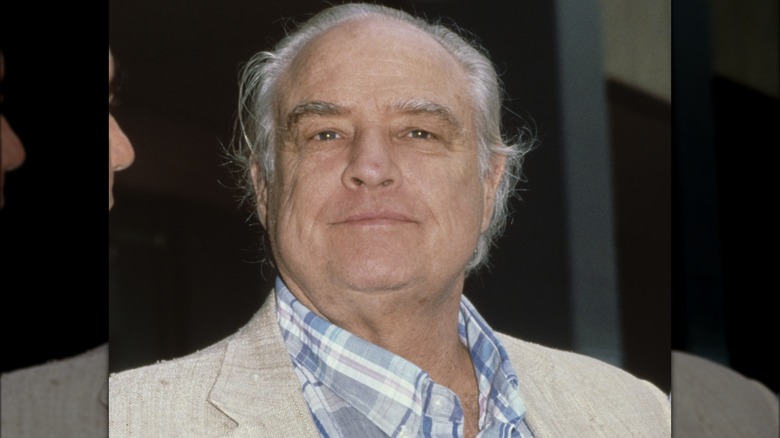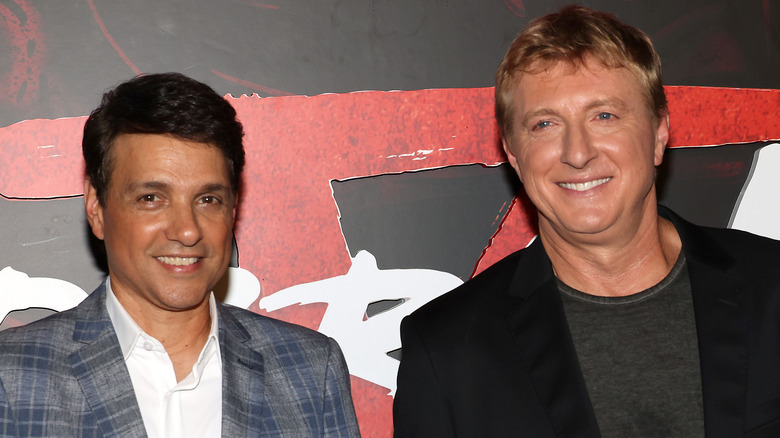Hollywood Comebacks That Proved These Stars Wouldn't Fade Away
The following article includes mentions of addiction, attempted suicide, and sexual assault allegations.
Everyone loves a comeback story, and Hollywood is filled with them. Sometimes, an actor takes a break from filming to spend time away from the industry, gets in trouble with the law, or they lose out on jobs due to low ticket sales. Whatever the reason, it's not uncommon for someone who was once incredibly popular to experience a career slump. These slumps can go on for months or, in many cases, several years.
When a celebrity's work diminishes, they can fade into the background and be forgotten by the public, which is arguably one of the worst things to happen to someone who works in Tinseltown. That's perhaps why comeback stories are so fascinating, and some of the biggest stars in Hollywood have experienced them. Everyone here — from Marlon Brando to Brendan Fraser — had a promising career that was upended at one point or another for a variety of reasons, but after facing a seemingly never-ending stall in their acting prospects, they managed to return to the spotlight in a big way. This not only reminded the world that they were still around, but some even managed to fly higher in popularity than ever before. And while it doesn't happen often, a good comeback story tends to rally fans behind someone they once supported.
These are the Hollywood comebacks that proved these stars wouldn't fade away.
Iron Man brought Robert Downey Jr. back to Hollywood
Robert Downey Jr. began acting when he was five, thanks to his father's film "Pound." He later joined Hollywood's Brat Pack, appearing in popular films throughout the decade like "Weird Science" and "Less than Zero." The most significant role in his early career came in 1992's "Chaplin," in which he played the lead. RDJ earned widespread critical acclaim and an Oscar nomination.
However, Robert's career soon took a major hit when his struggle with addiction caught up with him. The rising star was in and out of trouble due to alcohol and drug-related convictions, and he spent some time incarcerated in prison and rehabilitation facilities. Subsequent arrests tarnished his image further, but there was a light at the end of the tunnel. Robert began his recovery, and with a lot of work — and an ultimatum from future wife Susan Downey — he became sober in 2003. Unfortunately, his past and the high cost of insuring him made him virtually unemployable.
Things turned around when actor-director Jon Favreau pitched RDJ as Tony Stark in 2008's "Iron Man." Marvel rejected Favreau's casting choice multiple times, but he kept at it, telling 110.3 Jack FM, "Everybody knew he was talented. ... By studying the Iron Man role and developing that script, I realized that the character seemed to line up with Robert in all the good and bad ways. And the story of Iron Man was really the story of Robert's career. That was the big gamble. ... And now, he is the biggest star in the world."
If you or anyone you know needs help with addiction issues, help is available. Visit the Substance Abuse and Mental Health Services Administration website or contact SAMHSA's National Helpline at 1-800-662-HELP (4357).
Brendan Fraser became an Internet darling when he returned
Brendan Fraser began acting professionally in 1991, and the following year, he had a breakout performance in "School Ties." That role led to wide exposure across various genres, and he landed the leads in "George of the Jungle" and "The Mummy" trilogy. For much of the early 2000s, Fraser was everywhere, and he had fans around the world. However, his onscreen work began to slow toward the 2010s, but not because the offers weren't coming in.
Fraser experienced several personal issues and serious injuries that required multiple surgeries. In an interview with GQ, Fraser described his health: "By the time I did the third "Mummy" picture in China, I was put together with tape and ice." He also publicly accused Philip Berk, the former president of the Hollywood Foreign Press Association, of sexual molestation in 2018, claiming that the HFPA blacklisted him after the 2003 incident — which is why he's not a fan of the Golden Globes.
Fraser continued to work in a diminished capacity but began making a comeback in 2018 via roles on television in what's been dubbed the "Brenaissance." In 2022, he triumphantly returned to a leading feature film role — playing Charlie in "The Whale" to widespread critical acclaim, nods around the awards show circuit, and a six-minute standing ovation at the Venice International Film Festival, which moved him to tears. Add to that the absolute love and devotion Fraser's received on social media since his return to the limelight, and his comeback is already the stuff of legend.
If you or anyone you know has been a victim of sexual assault, help is available. Visit the Rape, Abuse & Incest National Network website or contact RAINN's National Helpline at 1-800-656-HOPE (4673).
Matthew McConaughey played against type and rebranded himself
Matthew McConaughey had his breakout performance in 1993's "Dazed and Confused," which led to his eventual casting in a lead role in "A Time to Kill." He followed this up with several notable gigs throughout the '90s but transitioned genres in 2000s. McConaughey's switch to romantic comedies had two impacts on his career: he became a sex symbol, and he was typecast.
Being typecast isn't McConaughey's style, so his agent turned down further romcom offers, and the star backed away from Hollywood until the right role came along. He spent two years not making movies, which was unusual for McConaughey, and he admitted to The Guardian, "I feel like I always need to be accomplishing something, for my own happiness and significance. I gotta work. The anxiety was in how long will it be dry, how long will we get nothing?" But something had to change after the last of McConaughey's romcoms, 2009's "The Ghosts of Girlfriends Past," failed to woo audiences or critics.
Fast-forward to 2012, and McConaughey experienced a career renaissance via "The Lincoln Lawyer," which reminded Hollywood that he could play serious roles. The following year, he gave an Oscar-winning performance as Ron Woodroof, a hustler with AIDS who helps others with the condition get the medication they need, in "Dallas Buyers Club." McConaughey's comeback was so monumental for his career that it's been called his "McConaissance." According to The New Yorker, this new era has been "the clever (and purposeful) undoing of a mythos and embrace of a more authentic McConaughey."
Winona Ryder put the past behind her with some stranger things
Throughout the 1980s, Winona Ryder was everywhere, appearing in "Lucas," "Beetlejuice," and "Heathers." She continued paving her way through Hollywood with hits that earned her two Academy Award nominations in the early '90s. But the "Girl, Interrupted" star's career hit a wall in December 2001 when she was arrested for shoplifting and drug possession in Beverly Hills. Ryder was convicted of felony grand theft and vandalism, given probation and community service, and was ordered to attend counseling.
As a result of her public legal trouble, Ryder became uninsurable and lost out on starring in Woody Allen's "Melinda and Melinda" the following year. But as she later reflected on the incident to Net-A-Porter (via HuffPost), "Psychologically, I must have been at a place where I just wanted to stop. ... It allowed me time that I really needed." Things fortunately changed in 2006, when Ryder returned to acting in independent films. She'd go on to play Spock's mother in "Star Trek" and Beth Macintyre in "Black Swan," but her career skyrocketed in 2016 thanks to a certain Netflix series.
Ryder was cast as Joyce Byers in "Stranger Things," and she's absolutely stunned in the role, showing off her amazing range of talent by exhibiting nearly every emotion possible throughout the seasons. She's also served as an '80s expert and mentor for the younger cast members. Ryder's past struggles were precisely that — in the past, and her career found new life with numerous high-profile gigs, including appearing in 2023's "Haunted Mansion."
Neil Patrick Harris went from child star to Barney Stinson
Neil Patrick Harris began his professional acting career in "Clara's Heart," which earned him a Golden Globe nomination. Not long after, he was cast as the lead of "Doogie Howser, M.D.," in which he starred from 1989 to '93. After ending that series, Harris landed walk-on roles on television and several minor roles in films, including 1997's "Starship Troopers," before he somewhat disappeared from the public eye. Much of his work throughout the early 2000s was behind the microphone and in the theater. "I was only getting jobs I was offered, not the ones I was auditioning for, because I had previous baggage," Harris explained to The New York Times of the challenge of shedding his child star image.
In 2004, he had an iconic cameo in "Harold & Kumar Go to White Castle." Harris played a parody of himself, which was entirely antithetical to the star's personality and reputation. The comedic role reignited interest in seeing Harris onscreen, and in 2005, he was cast as Barney Stinson in "How I Met Your Mother." His character became a fan favorite, and NPH received four Emmy nominations to boot.
Needless to say, "HIMYM" completely revitalized Harris' multi-faceted career, putting him front and center in a primetime series that ran for nine seasons and opening new doors. In addition to hosting the Academy Awards, the Emmys, and the Tonys, Harris has also landed leading roles in Netflix's "A Series of Unfortunate Events," "Hedwig and the Angry Inch" on Broadway, and the 60th anniversary special of "Doctor Who."
Drew Barrymore got clean and became a major player
Drew Barrymore's breakout role came in 1982 when the seven-year-old played Gertie in "E.T. the Extra-Terrestrial." From there, Barrymore continued acting and was often in the spotlight. She comes from Hollywood royalty, so she did well with all the attention, but her career brought other problems. When she was 14, Barrymore revealed to People that she had her first drink when she was nine, started smoking pot at 10, got into harder drugs by 12, and later attempted suicide.
This resulted in Barrymore's mother placing her in a psychiatric treatment facility for 18 months to get sober. "It did give an amazing discipline," the actor told The Guardian, adding, "My life was not normal ... and I needed some severe shift." When Barrymore emancipated herself at age 15 and set out to rebuild her career, the public attention surrounding her struggles made doing so difficult. Barrymore's rebellious image took a further toll as she acted out in public, flashing her breasts on "The Late Show with David Letterman" and posing for Playboy, which upset godfather Steven Spielberg. Though Barrymore later found her antics embarrassing, she didn't regret this phase of her life.
Barrymore's comeback came in the mid-'90s when she landed high-profile roles in "Boys on the Side," "Scream," and "The Wedding Singer." From there, she continued collaborating with pal Adam Sandler and started her Flower Films, Inc. production company. Though Barrymore retired from acting in films after having kids, she still works in the industry. In 2020, she launched "The Drew Barrymore Show" to great success.
If you or anyone you know needs help with addiction issues, help is available. Visit the Substance Abuse and Mental Health Services Administration website or contact SAMHSA's National Helpline at 1-800-662-HELP (4357).
If you or anyone you know is having suicidal thoughts, please call the National Suicide Prevention Lifeline by dialing 988 or by calling 1-800-273-TALK (8255).
Dave Chappelle came back in a big way after 12 years
Dave Chappelle got his start on "Def Comedy Jam," and before long, he was in "Robin Hood: Men in Tights." He acted in several high-profile movies throughout the '90s, and in 2000, he got his first HBO stand-up special "Killin' Them Softly." Amid his wild popularity, he scored "Chappelle's Show" on Comedy Central in 2003. It made the comedian a household name, but in 2005, Chappelle abruptly exited his own series, passed on a $50 million paycheck, and went to South Africa, per Esquire.
At the time, Chappelle almost completely left the entertainment industry. "I thought I ruined my career," he recalled on "My Next Guest Needs No Introduction with David Letterman." Admitting that he'd struggled with fame, Chappelle explained, "When the specter of making it left the room and I was just doing it ... it made me a better comedian." He would appear intermittently at impromptu performances around the country, but he wasn't a headliner anymore. Chappelle wouldn't regain that status until 2013 when he launched his first full-time tour. While he dealt with hecklers and earned some negative headlines, Chappelle continued to land increasingly more prominent shows — and in 2016, he hosted "Saturday Night Live" for the first time.
Chappelle's major return to the spotlight came with a lucrative Netflix deal, which produced three comedy specials between 2017 and 2022. While his career comeback was well on its way, Chappelle has faced major backlash over certain controversial jokes that have been dubbed transphobic.
Ke Huy Quan won a Golden Globe after a 30-year break
In 1984, Ke Huy Quan played Short Round in "Indiana Jones and the Temple of Doom" and followed that up as Data in "The Goonies." He was one of those kids everybody knew, even if they didn't know his name. Quan then landed sporadic roles throughout the 1990s, but pretty much disappeared from on-camera work by the turn of the century.
"The irony ... is that I didn't pursue acting when I was a little kid. But as I got older, in my late teens and early 20s, I really took it seriously," Quan explained to GQ, adding, "There were just not a lot of opportunities for me. It was extremely difficult for an Asian actor at that time." He instead worked as an assistant fight choreographer on "X-Men," and earned other assistant gigs on various film sets. Things changed in 2018 when Quan watched "Crazy Rich Asians" — seeing so many prominent Asian actors onscreen renewed his faith in Hollywood. The Daniels later cast him as Waymond Wang, one of the leads of 2022's "Everything Everywhere All at Once."
Quan was sensational in the film and earned a Golden Globe for best supporting actor. In his acceptance speech, Quan explained how he spent 30 years thinking he would never achieve the success he had as a child, tearfully thanked Steven Spielberg for casting him decades earlier, and the Daniels for remembering him. With an upcoming gig in the second season of "Loki," Quan's future is promising, to say the least.
Michael Keaton took time off before becoming Birdman
Michael Keaton's career kicked off in the 1970s, but the '80s was his decade. That's when he landed leading roles in "Night Shift," "Mr. Mom," "Johnny Dangerously," "Beetlejuice," and, of course, "Batman." Keaton continued working into the 1990s, but then he decided to do something many actors avoid: he took a break from Hollywood. That's not to say he wasn't working — he has plenty of voice-over credits that say otherwise. Instead, he stopped being a leading man and quietly faded into the background.
Keaton explained his decision to step back from acting in a 2017 interview with The Guardian: "There was me getting bored, hearing the sound of my voice, seeing the same old tricks. So I may have lost interest, combined with a whole lot of people not knocking on my door." He went on to explain that he was tired of being famous, saying, "I really like life. Doing things, having a normal life. So there was that."
The star ultimately decided to end his self-imposed exile to his ranch in Montana in 2014, with his big return to the screen in "Birdman or (The Unexpected Virtue of Ignorance)." The film's plot closely mirrors Keaton's life; he was perfect for the role. He was nominated for an Academy Award and went on to join the Marvel Cinematic Universe as Adrian Toomes/The Vulture. Keaton's career has undeniably come back swinging, and he continues to one-up himself as he moves forward.
Charlie Chaplin was driven out of Hollywood
Charlie Chaplin spent over 75 years entertaining the world and was beloved for it. Chaplin started in Vaudeville before moving to the United States to star in movies during the silent film era, during which the Brit developed his famous Tramp persona and took Hollywood by storm. Many of his films are considered Golden Age classics, and over a century later, they hold up.
Chaplin eventually co-founded United Artists, so he could create a place that let artists be artists without studio interference. This worked for some time, and in 1940, he released his first talkie "The Great Dictator." The film satirizes Adolph Hitler and features one of the greatest speeches in movie history. Unfortunately, the film also brought a great deal of controversy, and Chaplin's popularity declined. His movies became more political, and he became the target of McCarthyism in 1952, per the Daily Beast. Add to that the legal problems of a paternity suit, and Chaplin was effectively driven out of the U.S. and blacklisted from Hollywood. It was a great fall for such an amazingly talented performer, who later satirized McCarthyism in 1957's "A King in New York."
While his decades-long exile was largely self-imposed, he wasn't officially invited back to the country that was once his home until 1972, when he accepted an honorary Academy Award for his life's work. Chaplin received a standing ovation lasting several minutes and said, "I feel as if I were the object of a complete renaissance — as if I were being reborn."
Mickey Rourke went from the blacklist to the A-list
Mickey Rourke had a strong career in the 1980s, landing critically acclaimed roles in "Diner," "9½ Weeks," and "Barfly." However, his popularity declined as the '90s came around. Rourke gained a reputation for being difficult to work with and was blacklisted. He began drinking excessively, fighting, and spending his money so recklessly he nearly blew it all. As a sort of self-therapy, the A-lister turned his back on showbiz in 1991 and went back to doing something he'd enjoyed in his youth: boxing.
According to BoxRec, Rourke wasn't bad as a professional light heavyweight boxer, managing to win six and draw two fights, but he sustained several injuries, such as breaking his nose twice and splitting his tongue. He hung up his gloves in 1995 and began the arduous climb back up the ladder in Hollywood. Unfortunately, his subsequent facial reconstruction surgery made him look nothing like he did before leaving.
Following a string of supporting parts, Rourke landed a leading role in 2005's "Sin City" and received numerous awards and nominations for his performance in "The Wrestler" in 2008 — making his comeback official. "If I knew 15 years ago that it was going to take 15 years to get back in the saddle and work again because of the way I handled things, I really would have handled things differently," the "Iron Man 2" villain told Film Journal. "... Understanding what it is to be a professional, be responsible, be consistent — those are things that weren't in my vocabulary back then."
John Travolta faded into obscurity until Tarantino came along
John Travolta's first foray into fame came via "Welcome Back, Kotter," which aired through the latter half of the 1970s. After that, he starred in some of the decade's biggest hits, including "Saturday Night Fever" and "Grease." While Travolta continued working through the 1980s, his celebrity status faded. He began losing roles to other actors and inexplicably turned down several parts that went to Tom Hanks, including "Forrest Gump." Meanwhile, the movies he did appear in failed to attract attention.
In 1989, he starred in "Look Who's Talking," and for a minute, it looked like his career was back on track. However, the second sequel, 1993's "Look Who's Talking Now," was a critical and commercial failure — it has a 0% on Rotten Tomatoes. At the time, his agent told Vanity Fair, "John Travolta was at that time as cold as they get. He was less than zero." But then Quentin Tarantino came along and cast him as Vincent Vega in "Pulp Fiction." Out of nowhere, Travolta returned to the limelight, and his career was revitalized.
"Pulp Fiction" put Travolta at the center of attention in the most talked-about independent movie of 1994. After that, he was given leading roles in several commercially successful films, including "Broken Arrow," "Phenomenon," "Michael," and "Face/Off." Travolta's career comeback was monumental, but it unfortunately didn't last. He went back to appearing in critical and commercial flops like "Battlefield Earth," and his films in the 2010s didn't improve. With any luck, Travolta may yet have another comeback up his sleeve.
Marlon Brando went from washed-up to declining an Oscar
Marlon Brando is one of the most well-known actors to grace the silver screen, and his remarkable career began in the theater in the 1940s. He gained widespread acclaim for his portrayal of Stanley Kowalski in "A Streetcar Named Desire," which earned him an Academy Award nomination. In 1954, he won an Academy Award for playing Terry Malloy in "On the Waterfront," and he was a prominent actor throughout the decade. The '60s weren't as kind to Brando, however, and his career took a turn.
Most of his work throughout the decade amounted to a string of commercial failures. This made the actor difficult to employ because studios were apprehensive about casting Brando in much of anything. While he worked throughout the decade, it would take 10 years before Brando saw his star rise again. On novelist Mario Puzo's suggestion, Francis Ford Coppola eyed him for Don Vito Corleone in "The Godfather." He essentially had to go to war with the studio to get him approve — but it's a good thing he did, because that performance returned Brando to superstardom, and he won his second Academy Award, which he infamously declined.
Brando was, once again, at the top of his game in Hollywood. He transitioned primarily into character acting with some of his most notable roles. The star played Colonel Kurtz in "Apocalypse Now" and Jor-El in "Superman" and "Superman II." Brando continued to work in films until his death in 2004, and he's widely recognized as one of the 20th century's greatest actors.
Ralph Macchio and William Zabka kept their feud going
In 1984, Ralph Macchio and William Zabka starred in "The Karate Kid," which became a pop culture phenomenon. The film created a franchise of sequels, a reboot, and more. After the movie, Macchio and Zabka continued their careers, but while they both landed work for years, they faded into the background. Macchio's most significant role was likely 1992's "My Cousin Vinny," while Zabka's was probably 2010s "Hot Tub Time Machine." They were working, but neither had the star power they enjoyed in the 1980s.
Then, seemingly out of nowhere, Macchio and Zabka reunited for an episode of "How I Met Your Mother," where they played themselves and touched on their former onscreen rivalry. While the episode didn't lead to anything directly, Josh Heald, the director, writer, and producer of "Cobra Kai," told CBR in 2020 that it "kind of buoyed us a little bit when we were conceiving the show and comparing the storylines to pitch the show because it made us feel confident that we weren't the only ones."
In 2018, "Cobra Kai" brought Zabka and Macchio back together, and the show was an instant success. It premiered on YouTube Red and remained for the second season. After that, Netflix picked it up, and the series received critical acclaim. Zabka and Macchio have enjoyed massive comebacks due to the series' success, and they received Primetime Emmy nominations for co-executive producing "Cobra Kai" in 2021. While they've rekindled their onscreen rivalry, Macchio and Zabka have remained close friends in real life.

